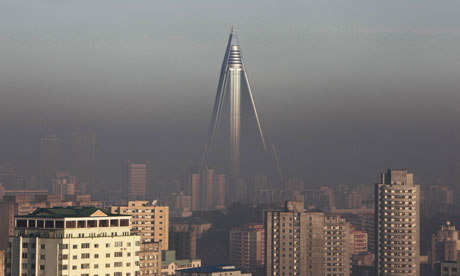(The Guardian) — North Korea's test-launch of two short-range missiles this week has raised anxiety levels in the region, as the regime in Pyongyang prepares to defy international opinion with the launch next month of a long-range rocket, which many believe is connected to its ballistic missile programme
South Korean defence officials said that North Korea had launched two surface-to-ship missiles from a site on its west coast early on Wednesday, a day after world leaders attending a nuclear security summit in Seoul urged the regime to cancel the rocket launch and return to six-party nuclear talks.
North Korea insists that the forthcoming launch, which is expected around 15 April to coincide with the centenary of the birth of the country's founder Kim Il-sung, is designed to put an observation satellite into orbit.
The US, South Korea and Japan, however, say it would be a violation of UN security council resolutions banning North Korea from missile activity, as the same technology could be developed for use in multistage missiles, including those capable of hitting the US mainland.
If the launch goes ahead it will immediately kill off a deal, which was reached at the end of February, in which the US agreed to provide 240,000 tonnes of food aid provided that Pyongyang end its uranium enrichment programme and tests of long-range and nuclear missiles.
The prospect of a fourth North Korean long-range missile launch since 1998 is causing disquiet across the region, partly due to concerns that it will veer off course and potentially dump debris on its neighbours' territory.
On Friday Indonesia's foreign minister Marty Natalegawa urged North Korea to abandon the launch, saying it would "undermine peace and stability in the region".
The Philippine president, Benigno Aquino, said he was concerned that debris may fall on his country's territory, calling the planed launch a "needless provocation".
Japan is concerned that the rocket may fly over the southern island chain of Okinawa and has ordered its self-defence forces to intercept the rocket or its fragments if they pose a threat.
In an unusual show of transparency, Pyongyang has told the international maritime organisation that the rocket will be launched between 7am and noon from 12-16 April. The first stage of the Unha-3 rocket will come down about 87 miles (140km) off the west coast of South Korea, while the second will fly over a chain near the main Okinawa island before falling into the sea east of the northern Philippines.
Japan's defence minister, Naoki Tanaka, said the odds of the rocket striking Japan were low, but added: "We want to be fully prepared for the possibility of rocket fragments falling on our territory."
Japan will deploy ground-based Patriot Advanced Capability-3 interceptor missiles in its south-west and Okinawa, and send three Aegis-equipped destroyers carrying missile defence systems to the Japan Sea and East China Sea.
Experts doubt Japan has the ability to shoot down the rocket in mid-flight; instead, the precautionary moves appear to be aimed at reassuring the public that Tokyo is taking North Korea's latest provocation seriously.
The planned launch is causing particular alarm in Japan, which is already within striking distance of North Korea's medium-range Rodong missiles.
In a report published on Friday, the national institute for defence studies in Tokyo warned that North Korea's progress on nuclear technology, coupled with recent regime change, had increased the risk of conflict breaking out in the region.
Satellite images taken earlier this week show North Korea is making preparations for the missile launch from its Tongchang-ri site, located about 35 miles from the northern border with China. Expert analysis showed trucks and fuel tanks outside two large buildings used to store propellant for the rocket, although the rocket itself was not visible.
Subscribe to:
Post Comments (Atom)



No comments:
Post a Comment